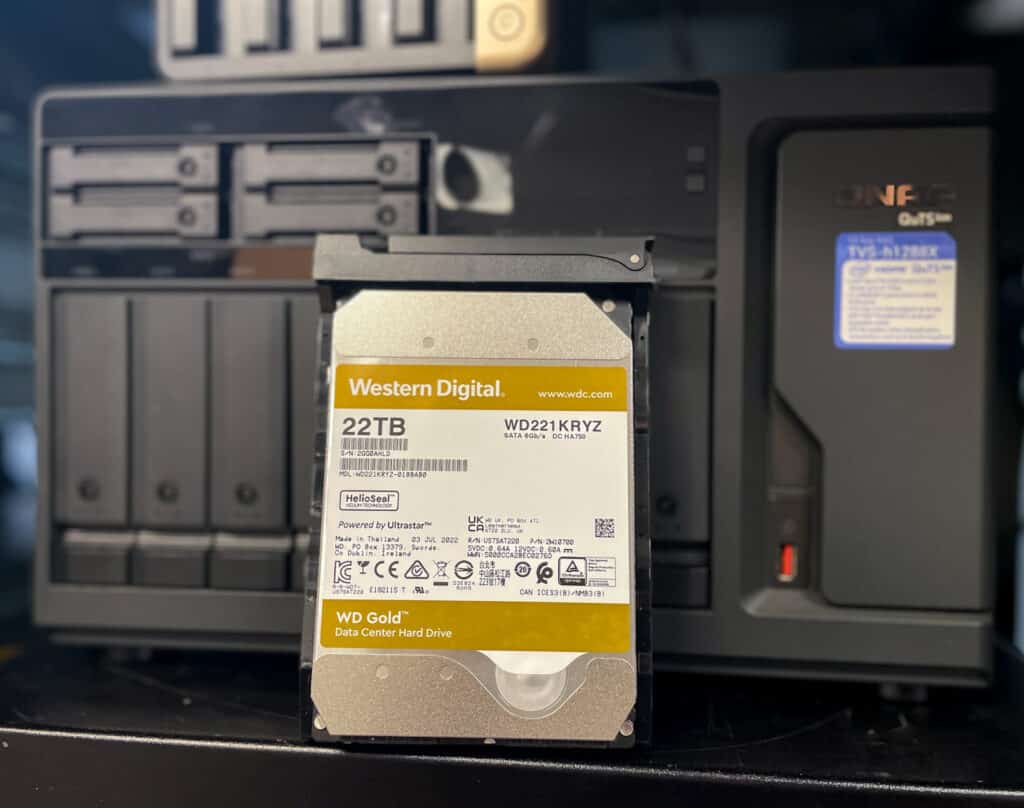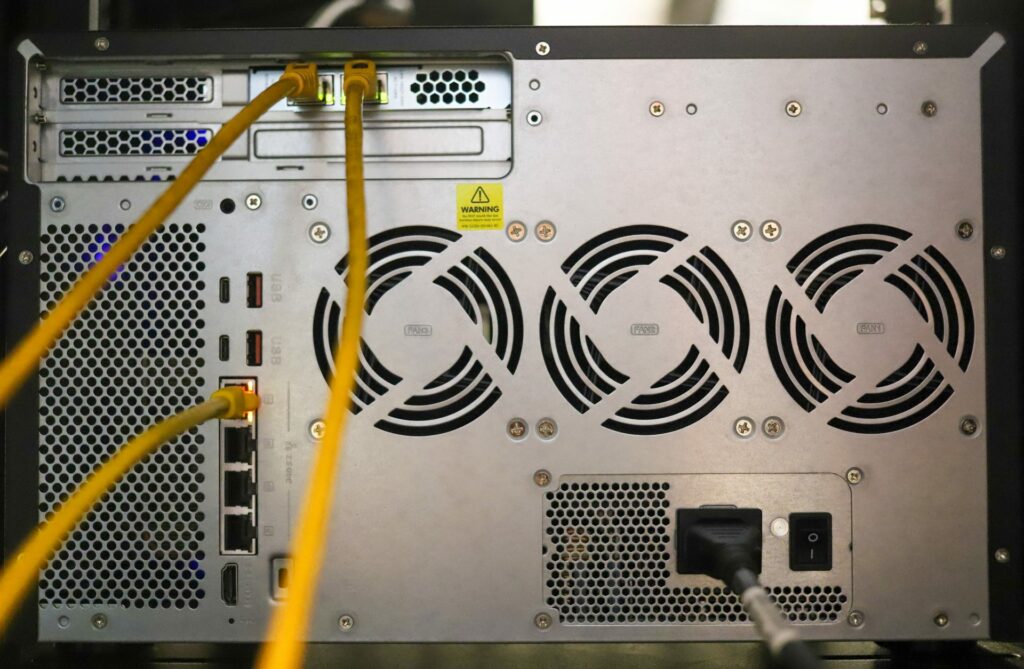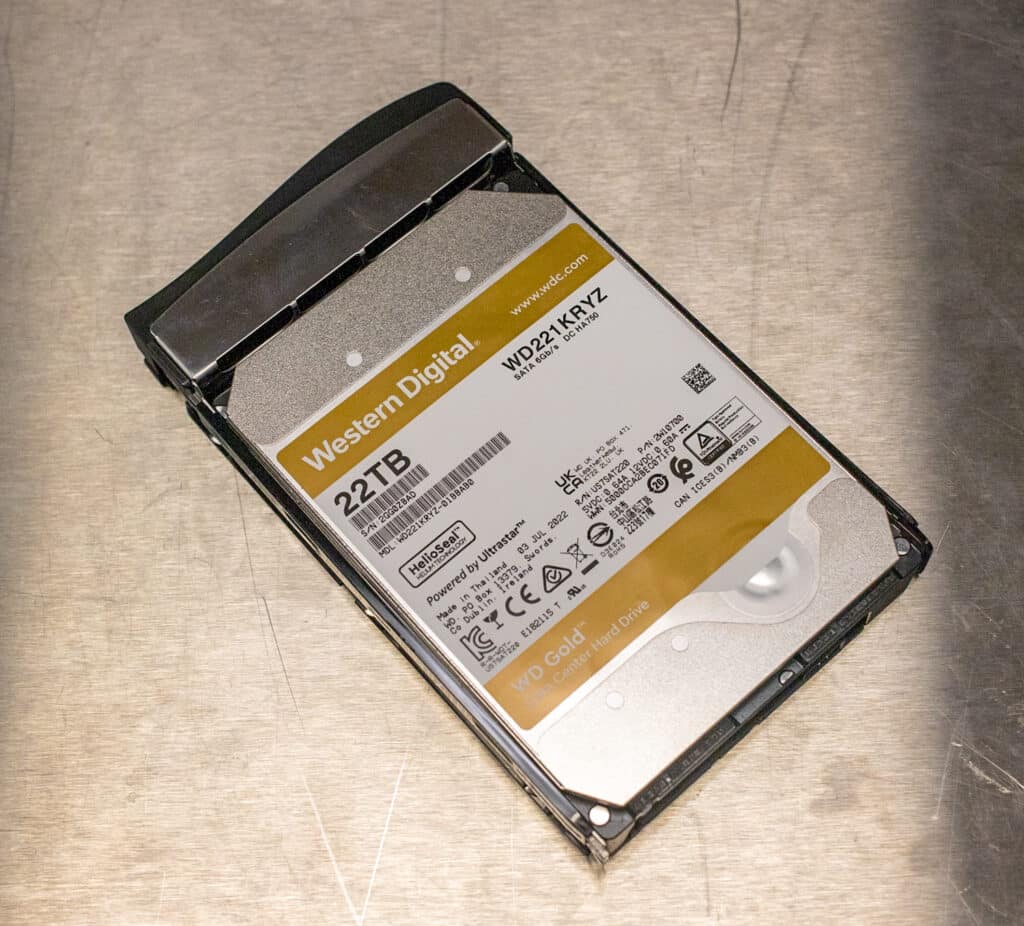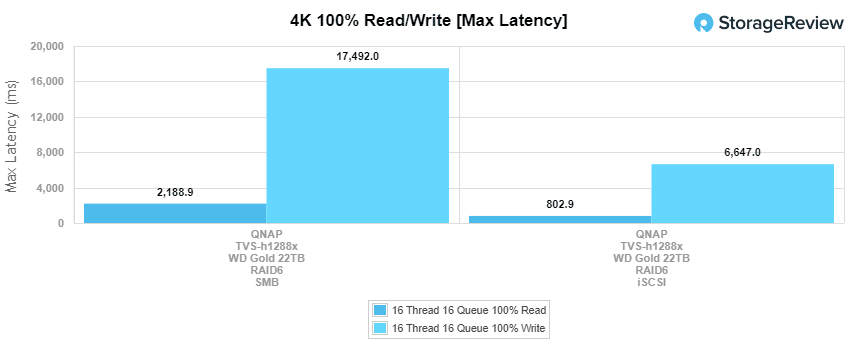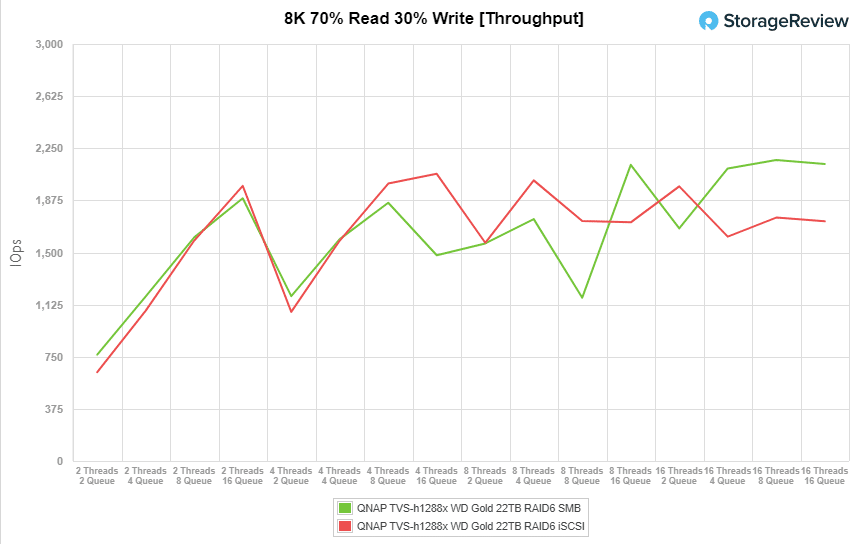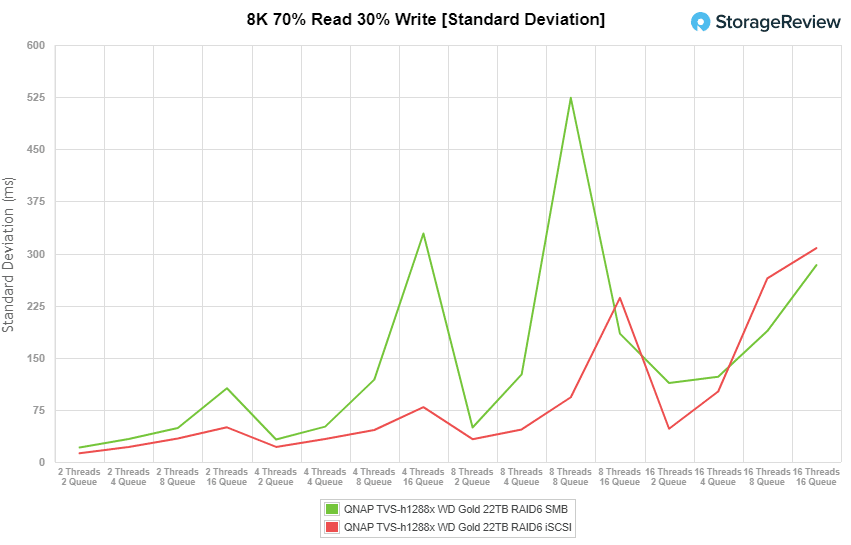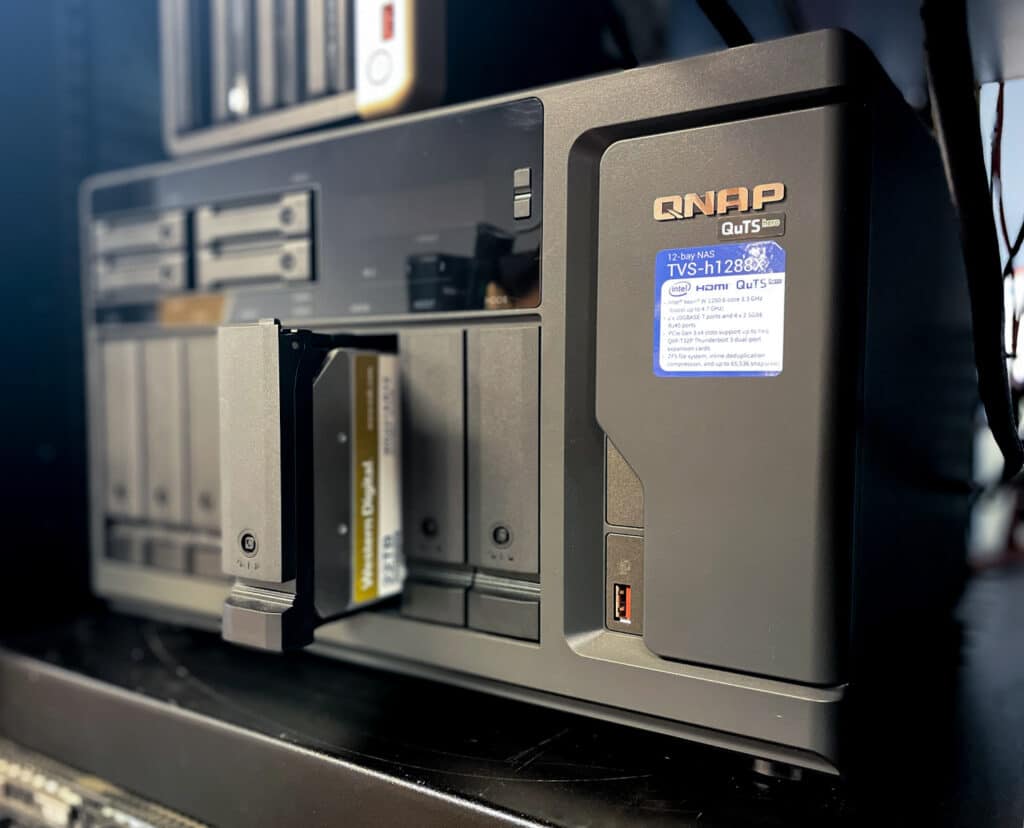Continuing on with our WD Gold 22TB SMB performance series, we will look at how these enterprise-grade drives fare when populated inside the QNAP TVS-h1288X. In our last review, we were impressed with the results when combining the 22TB WD drives with the Synology DiskStation DS1821+. Configurations like these will certainly give businesses more flexibility in available storage and performance, as well as a smaller footprint to boot. We expect more of the same when using the TVS-h1288X.
Continuing on with our WD Gold 22TB SMB performance series, we will look at how these enterprise-grade drives fare when populated inside the QNAP TVS-h1288X. In our last review, we were impressed with the results when combining the 22TB WD drives with the Synology DiskStation DS1821+. Configurations like these will certainly give businesses more flexibility in available storage and performance, as well as a smaller footprint to boot. We expect more of the same when using the TVS-h1288X.
QNAP TVS-h1288x Features
The QNAP TVS-h1288x is a 12-bay NAS highlighted by its comprehensive options for expansion and connectivity. The QNAP NAS leverages an Intel Xeon W CPU giving it six cores and support for up to two QNAP QXP-T32P Thunderbolt 3 PCIe expansion cards, which means a total of four available Thunderbolt 3 ports. As a result, users will benefit from speedy file transfers from supported devices that support Thunderbolt 3.
The TVS-h1288x can be outfitted with up to 128GB of ECC DDR4 RAM, though 16GB comes standard. The size of its RAM scalability potential is important for businesses that plan to use some of its enterprise features such as virtualization. In addition, the NAS has built-in 10GbE and 2.5GbE (though 5GbE and 25GbE connectivity can be added via expansion slots. Overall, the TVS-h1288x is comprised of an ideal blend of both features and configurability, which makes it one of our favorite SMB NAS solutions in its price range.
WD Gold 22TB SMB Benefits and Use Cases
As we mentioned in our previous review, using the WD Gold 22TB drives with a NAS like the TVS-h1288x opens up huge possibilities for SMBs, including a massive storage repository via a small physical footprint. Even more so with the QNAP model compared to the Synology DS1821+, as the former is equipped with 12 bays vs. the latter’s 8 bays. Small professional offices can start out using just a few of the bays with the 22TB drives, then add more as their storage requirements increase.
Nonetheless, the WD Gold 22TB drives will give businesses more flexibility and scalability no matter what their use case might be.
Setup and Configuration
We used QTS (QNAP’s NAS operating system) to manage and set up the WD Gold-populated TVS-h1288x. Among the comprehensive suite of apps available, the Storage & Snapshots (more specifically, the Volume Creation Wizard) allows users to set up RAID, pools, and volumes.

And again, we had to then make a second volume to use the rest of the pool space.
WD Gold HDD 22TB Specifications
| Model Number | WD221KRYZ |
| Form factor | 3.5-inch |
| Interface | SATA 6 Gb/s |
| 512n / 512e user sectors per drive4 | 512e |
| Formatted capacity | 22TB |
| OptiNAND technology | Yes |
| RoHS compliant | Yes |
| Performance | |
| Data transfer rate (max Sustained) | 291MB/s |
| RPM | 7200 |
| Cache | 512MB |
| Power Management | |
| Average power requirements (W) | |
| Operational | 7.1W |
| Idle | 5.7W |
| Power efficiency index (W/TB, idle) | 0.26 |
| Reliability | |
| MTBF (hours, projected) | 2,500,000 |
| Annualized Failure Rate2 (AFR, %) | 0.35 |
| Limited Warranty | 5 years |
| Environmental | |
| Operating temperature | 5°C to 60°C |
| Non-operating temperature | -40°C to 70°C |
| Shock (Read/Write)
Operating (half-sine wave, 2ms) |
40G/40G |
| Non-operating (half-sine wave, 2ms) | 200G |
| Acoustics (average) | |
| Idle Mode | 20 dBA |
| Seek Mode | 32 dBA |
| Physical Dimensions | |
| Height (max) | 26.1mm |
| Length (max) | 147.0mm |
| Width (± .01 in.) | 101.6mm |
| Weight | 1.47 lb (.67 kg)
± 10% |
QNAP TVS-h1288x Specifications
| CPU | Intel Xeon W-1250 6-core 3.3 GHz processor (boost up to 4.7 GHz) |
| CPU Architecture | 64-bit x86 |
| Graphics Processors | Intel UHD Graphics P630 |
| Floating Point Unit | Yes |
| Encryption Engine | Yes (AES-NI) |
| Hardware-accelerated Transcoding | Yes |
| System Memory | 16GB ECC UDIMM DDR4 (2 x 8 GB) |
| Maximum Memory | 128GB (4 x 32 GB) |
| Memory Slot | 4 x Long-DIMM DDR4 |
| Flash Memory | 5GB (Dual boot OS protection) |
| Drive Bay | 8 x 3.5-inch SATA 6Gb/s, 3Gb/s + 4 x 2.5-inch SATA 6Gb/s, 3Gb/s |
| Drive Compatibility |
|
| Hot-swappable | Yes |
| M.2 SSD Slot | 2 x M.2 22110/2280 NVMe PCIe Gen3 x4 slots |
| SSD Cache Acceleration Support | Yes |
| 2.5 Gigabit Ethernet Port (2.5G/1G/100M) | 4 (also support 10M) |
| 5 Gigabit Ethernet Port (5G/2.5G/1G/100M) | Optional via an adapter |
| 10 Gigabit Ethernet Port | 2 x 10GBASE-T (10G/1G) |
| 25 Gigabit Ethernet Port | Optional via an adapter |
| Wake on LAN (WOL) | Yes |
| Jumbo Frame | Yes |
| Thunderbolt Port | Optional via the QXP-T32P 2-port Thunderbolt 3 PCIe adapter |
| PCIe Slot |
|
| USB 3.2 Gen 2 (10Gbps) | 2 x Type-C Port 3 x Type-A |
| HDMI Output | 1, HDMI 1.4b (up to 4096 x 2160 @ 30Hz) |
| Form Factor | Tower |
| Dimensions (HxWxD) | 9.24 × 14.56 × 12.59 inch |
| Weight (Net) | 24.85 lbs |
| Weight (Gross) | 32.96 lbs |
| Operating temperature | 0 – 40°C (32°F – 104°F) |
| Storage Temperature | -20 – 70°C (-4°F – 158°F) |
| Relative Humidity | 5-95% RH non-condensing, wet bulb: 27 ̊C (80.6 ̊F) |
| Power Supply Unit | 550W PSU, 100~240V |
| Power Consumption: HDD Sleep Mode | 85.216 W |
| Power Consumption: Operating Mode, Typical | 97.492 W |
| Fan | System fan: 3 x 80mm, 12VDC CPU fan: 2 x 97mm, 12VDC |
| Sound Level | 26 db(A) |
| System Warning | Buzzer |
| Kensington Security Slot | Yes |
| Max. Number of Concurrent Connections (CIFS) – with Max. Memory | 10000 |
WD Gold HDD 22TB and QNAP TVS-h1288x Performance
Enterprise Synthetic Workload Analysis
As we indicated above, we previously reviewed the WD Gold 22TB inside the Supermicro server and Synology DiskStation DS1821+. This time around, we will be gauging its performance when installed into our QNAP TVS-h1288x (eight of the 12 drive bays drives configured in RAID6). We will be testing in both iSCSI and SMB protocols.
Our enterprise hard drive benchmark process preconditions each drive-set into steady-state with the same workload the device will be tested with under a heavy load of 16 threads, with an outstanding queue of 16 per thread. The device is then tested in set intervals in multiple thread/queue depth profiles to show performance under light and heavy usage. Since hard drives reach their rated performance level very quickly, we only graph out the main sections of each test.
Preconditioning and Primary Steady-State Tests:
- Throughput (Read+Write IOPS Aggregate)
- Average Latency (Read+Write Latency Averaged Together)
- Max Latency (Peak Read or Write Latency)
- Latency Standard Deviation (Read+Write Standard Deviation Averaged Together)
Our Enterprise Synthetic Workload Analysis includes four profiles based on real-world tasks. These profiles have been developed to make it easier to compare to our past benchmarks, as well as widely-published values such as max 4K read and write speed and 8K 70/30, which is commonly used for enterprise drives.
4K
- 100% Read or 100% Write
- 100% 4K
8K 70/30
- 70% Read, 30% Write
- 100% 8K
128K (Sequential)
- 100% Read or 100% Write
- 100% 128K
Our first throughput test measures 4K random performance when inside the QNAP TVS-h1288x. Here, the WD Gold 22TB posted similar performance between iSCSI and SMB configurations, which wasn’t the case with the Synology NAS. Specifically, it showed 5,578 IOPS in reads and 804 IOPS write (SMB) and 5,774 IOPS read and 978 IOPS write (iSCSI).
In average latency, the 22TB WD Gold was able to reach read and writes of 45.9ms and 318.2ms, respectively, in SMB, while iSCSI posted 44.3ms read and 261.44ms write.
Moving on to the max latency, the WD Gold hit 2,188.9ms read and 17,492ms write in SMB, while the reaching 802.88ms read and 6,647ms write in iSCSI.
For standard deviation, the WD Gold recorded 40ms read and 1,075.1ms write in SMB, and 44.86ms read and 203.95ms write in iSCSI.
Our next benchmark subjects the drives to 100% read and write activity at 8K sequential throughput. When inside the QNAP TVS-h1288x, the 22TB WD Gold drive showed 151,481 IOPS read and 96,064 IOPS write in SMB, while reaching 206,476 IOPS read and 142,538 IOPS write in iSCSI.
Our next test shifts focus from a pure 8K sequential 100% read/write scenario to a mixed 8K 70/30 workload, which will demonstrate how performance scales in a setting from 2T/2Q up to 16T/16Q.
Up first is throughput, where the WD Gold 22TB had a range of 765 IOPS to 2,137 IOPS in SMB and 639 IOPS to 1,724 IOPS in iSCSI.
With average latency at 8K 70/30 using a QNAP TVS-h1288x, the 22TB Gold 22TB posted 5.22ms through 118.83ms in SMB, while iSCSI recorded a range of 6.25ms through 148.32ms.
Moving on to max latency numbers, the 22TB WD Gold had a range of 1,713.61ms to 6,979.94ms in SMB while the iSCSI showed 500.01ms through 7,080.62ms.
For our standard deviation latency results, the 22TB Gold hit 20.99ms through 283.28ms (SMB) and 12.56ms to 307.77ms (iSCSI).
Our last test is the 128K benchmark, a large-block sequential test showing the highest sequential transfer speed. The WD Gold 22TB posted 1.03GB/s read and 947MB/s write in SMB, while iSCSI recorded 1.37GB/s read and an impressive 2.31GB/s write.
Conclusion
Overall, it has proven very useful to analyze the performance of leading desktop (or SMB) NAS form factors like the versatile QNAP TVS-h1288x when combined with the WD Gold 22TB drives, as the results of our tests certainly prove that it will bring a lot of flexibility to organizations. With the Gold’s massive capacity point and industry-leading performance for 3.5″ HDDs, organizations will be able to decrease their overall TCO and lower their physical footprint. SMBs that have huge data requirements will benefit the most from the WD Gold drives.
To test its performance, we added eight WD Gold 22TB drives inside the QNAP NAS and put it through our usual tests. Overall, we saw solid results across all of our benchmarking, especially when configured with the iSCSI protocol.
Specifics include 5,578 IOPS read / 804 IOPS write (SMB) and 5,774 IOPS read / 978 IOPS write (iSCSI) in random 4K, and 151,481 IOPS read / 96,064 IOPS write (SMB), and 206,476 IOPS read / 142,538 IOPS write (iSCSI) during the 8K sequential workload. Moreover, the WD Gold showed a range of 765 IOPS to 2,137 IOPS in SMB and 639 IOPS to 1,724 IOPS in iSCSI. For our large-block sequential test, it posted 1.03GB/s read and 947MB/s write in SMB, while iSCSI showed 1.37GB/s read and 2.31GB/s write.
Like in the case with the Synology DiskStation, the WD Gold 22TB fared very well when combined with the SMB-grade QNAP TVS-h1288x, posting solid numbers throughout (particularly in our 4K random and 8K sequential tests). With its 8 available HDD bays and 4 flash bays, the QNAP NAS will give professional offices a ton of flexibility to grow as well as the performance to go along with it.
Engage with StorageReview
Newsletter | YouTube | Podcast iTunes/Spotify | Instagram | Twitter | TikTok | RSS Feed

